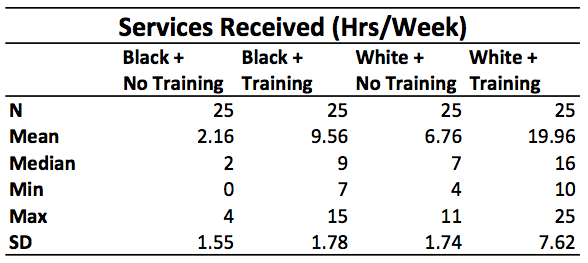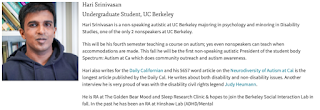This was an research paper written for my Psych 167AC Stigma and Prejudice Course with Prof Mendoza-Denton.
(NOTE: The data itself is all made up - that was the point of the project but all the lit review and findings very much reflect reality of the ground situation for many families with autism)
Impact of Parental Training and Race on Services Negotiated at an IEP
With a diagnosis rate of 1:54 children, Autism Spectrum Disorder or ASD, has of late become the most rapidly diagnosed neurodevelopmental disorder. As a result, an increasing number of children are entering the special education system. While free public education for non-disabled school age children in the United States has been around for more than a century, the inclusion of disabled students is fairly recent with the 1975 Individuals with Disabilities Education Act, or IDEA (DREDF, 2014). IDEA stipulates that students be included in the public education system with related services, “if students require them in order to benefit from specially designed instruction,” (DREDF, 2014). Given that autism is a spectrum disorder and can vary widely in how it affects a specific individual, there is no uniform set of services that can be applied across the board. Thus the type and hours of services a child actually receives is negotiated at the IEP (Individual Education Plan) meetings between the school district and the parents of the child. The only redress to IEP disagreements is through mediation and lawsuits which can be intimidating for parents who enter the system with little to no knowledge of disability education.
Parallelly, Correll et al. (2002), points to societal judgements made about the Black community; that they are somehow less deserving. Goff et al. (2014) highlights racial bias in that Black children are thought to be less innocent than their White counterparts. What this racial bias translates to is substantial delays in the diagnosis of ASD for Black children, after the parents initially expressed concerns about the child’s development, despite the parents having health insurance (Costantino et al., 2020). Delays in the referral process and lack of timely ASD diagnosis often meant missing the crucial early years of services that could potentially lead to better outcomes (Dababnah et al., 2018). Non-White parents were often told that it was not ASD or given other diagnoses (Martinez et al., 2018). The 2020 Obeid et al., study further demonstrated implicit racial bias in ASD identification and stigma. In the study, White participants were more likely to diagnose Black children with conduct disorder and White children with ASD while the reverse was true for Black participants. In addition, Black parents themselves would delay in reporting ASD symptoms, mistaking it for disruptive behaviors, compared to White parents, even if the symptoms were more severe (Donohue et al., 2017).
Hypothesis: Parents who undergo IEP training will get more hours of services for their autistic child from the public school district as compared to parents who don’t, and the service hours are moderated by race, such that White parents will receive more services for their autistic child than Black parents.
Method
The sample size was 100 parents (either father or mother) of children with a clinical ASD diagnosis of elementary age, attending a special education program in the United States. 50 of the parents were Black and 50 were White. Each racial group was further divided into two groups, the experimental condition attending a one day training on special education laws, legal rights and the IEP process. The control groups did not receive this IEP training.
The study uses a 2 x 2 design. The first factor of parental training was manipulated with two levels, training or no training. The second factor of race, had two levels, Black or White. The dependent variable in this study was the number of hours per week of related services negotiated at the child’s IEP meeting between the school district and the parents following the training (or control). Related services refer to additional services on top of what is provided to all students in a special education classroom. These include 1:1 support hours, speech therapy hours, occupational therapy hours, behavioral therapy hours etc. Aggregated data for the four levels were analyzed.
Results
Descriptive statistics of aggregated (fake) data for each of the four profiles are summarized in the table below. The mean for the different profiles is also represented in graphical form below.


Discussion
The data from the study supports the hypotheses. The above graph clearly demonstrates a main effect of parental training level, such that a IEP training is positively correlated to more service hours that are negotiated with the school districts at IEP meetings, independent of race There is a second main effect of race, such that the school district provides more service hours to White children rather than Black children. In addition, as is evident by the differing slopes of the two lines representing race in the graph, there is an interaction effect or a joint effect that cannot be explained away by each main effect in isolation. Thus while parental training leads to better outcomes in terms of service hours, this effect is moderated by race, such that being White leads to better outcomes than being Black.
Though it is not designed to be so, in reality the IEP has become an exercise in skill and artful negotiation. On the one side are school districts which are historically underfunded and under-resourced so will watch every dollar that needs to be spent despite laws that insist on appropriate supports to enhance inclusion. Part of the issue is the ongoing stigma around disability itself, that it would be a waste to spend resources on kids who would not improve anyway. On the other hand are the needs of autistic children; effective and timely delivery of support services can positively impact their outcomes further on in their lives.
The results of this study are therefore not surprising. A working knowledge of and training of their child’s rights under IDEA and understanding the IEP process gives parents the confidence to act as an equal amongst the professionals, educators and other experts that dominate the IEP table. Trained parents can argue for and justify the need for services. For the same reasons, trained parents are better equipped to go to mediation or sue in order to resolve IEP disagreements.
The other main effect of race has historically been an issue across the board as discussed earlier in the introduction section, and it is not surprising that this is the case when it comes to services received by Black children than White children. Black children may be seen as less deserving of services and more so if they have a disability which already has a lot of historical stigma attached to it. So while the trained Black parent is able to obtain more services than a non-trained parent (irrespective of race), the effect is dampened by the race factor. That is to say, for the Black parents, the gap in services has not closed due to the fact of training alone.
This study has major limitations. Outcomes cannot be limited to just two factors as there can be other extraneous issues that come into play. For instance, funding for school districts is often linked to property taxes and poorer neighborhoods housing minorities may be even more resource constrained. The severity of ASD and other comorbid diagnosis and conditions have also not been factored in.
A future direction would be to further examine this interaction effect and also examine the effects of severity of ASD, and resultant outcomes in terms of services received.
References
Constantino, J. N., Abbacchi, A. M., Saulnier, C., Klaiman, C., Mandell, D. S., Yi Zhang, Hawks, Z., Bates, J., Klin, A., Shattuck, P., Molholm, S., Fitzgerald, R., Roux, A., Lowe, J. K., & Geschwind, D. H. (2020). Timing of the Diagnosis of Autism in African American Children. Pediatrics, 146(3), 1–9. https://doi.org/10.1542/peds.2019-3629
Correll, J., Park, B., Judd, C., & Wittenbrink, B. (2002). The police officer's dilemma: Using ethnicity to disambiguate potentially threatening individuals. Journal of Personality and Social Psychology, 83(6), 1314-1329.
Dababnah, S., Shaia, W. E., Campion, K., & Nichols, H. M. (2018). “We Had to Keep Pushing”: Caregivers’ Perspectives on Autism Screening and Referral Practices of Black Children in Primary Care. Intellectual & Developmental Disabilities, 56(5), 321–336.
https://doi.org/10.1352/1934-9556-56.5.321Donohue, M. R., Childs, A. W., Richards, M., & Robins, D. L. (2019). Race influences parent report of concerns about symptoms of autism spectrum disorder. Autism: The International Journal of Research & Practice, 23(1), 100.
DREDF. (2014, March 09). Individuals with Disabilities Education Act (IDEA). Retrieved from
https://dredf.org/legal-advocacy/laws/individuals-with-disabilities-education-act-idea/Goff, P., Jackson, M., Di Leone, B., Culotta, C., & DiTomasso, N. (2014). The essence of innocence: Consequences of dehumanizing Black children. Journal of Personality and Social Psychology, 106(4), 526-545.
Martinez, M., Thomas, K. C., Williams, C. S., Christian, R., Crais, E., Pretzel, R., & Hooper, S. R. (2018). Family Experiences with the Diagnosis of Autism Spectrum Disorder: System Barriers and Facilitators of Efficient Diagnosis. Journal of Autism & Developmental Disorders, 48(7), 2368–2378.
https://doi.org/10.1007/s10803-018-3493-1Obeid, R., Bisson, J. B., Cosenza, A., Harrison, A. J., James, F., Saade, S., & Gillespie-Lynch, K. (2020). Do Implicit and Explicit Racial Biases Influence Autism Identification and Stigma? An Implicit Association Test Study. Journal of Autism and Developmental Disorders, 1.
https://doi.org/10.1007/s10803-020-04507-2







.jpg)














